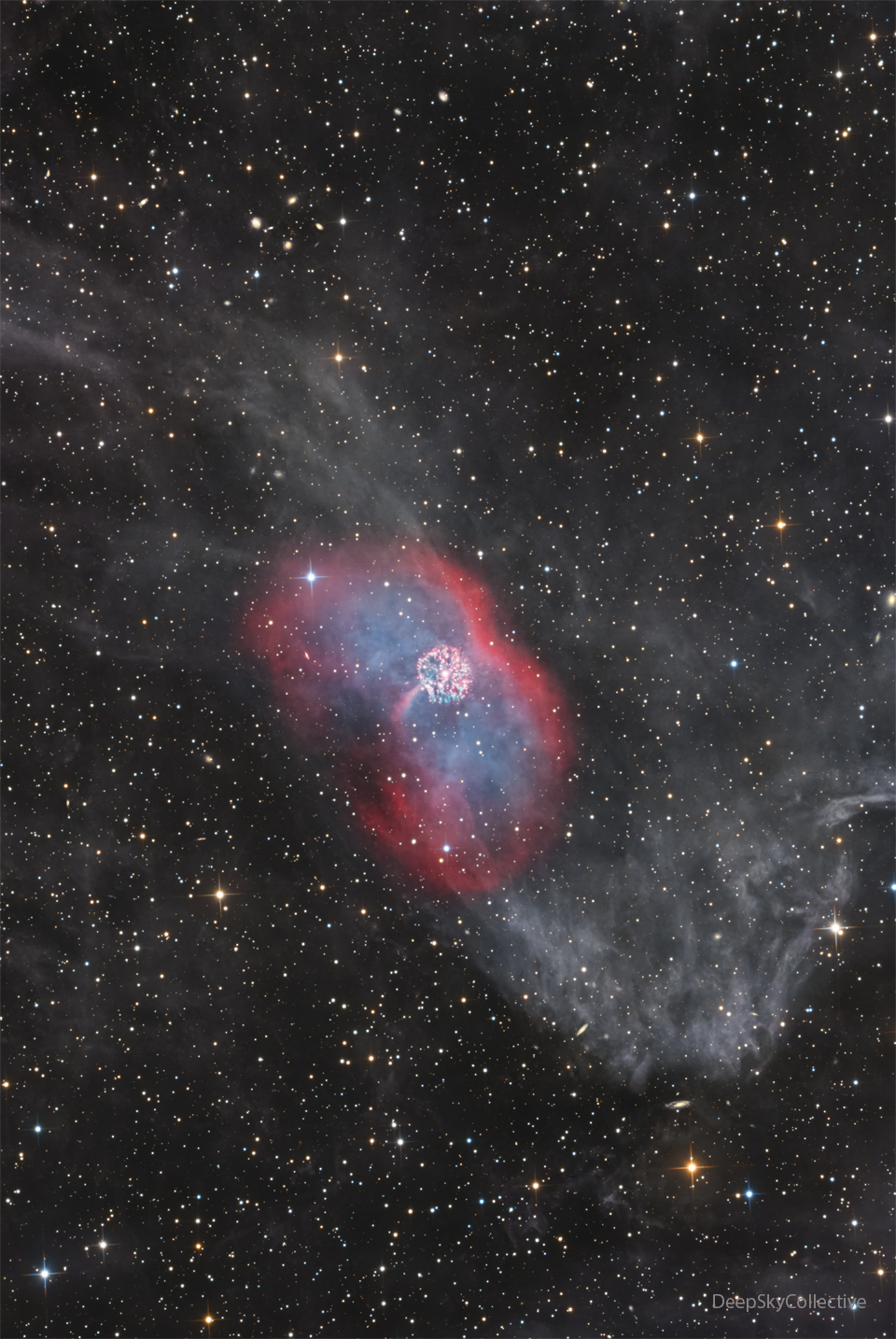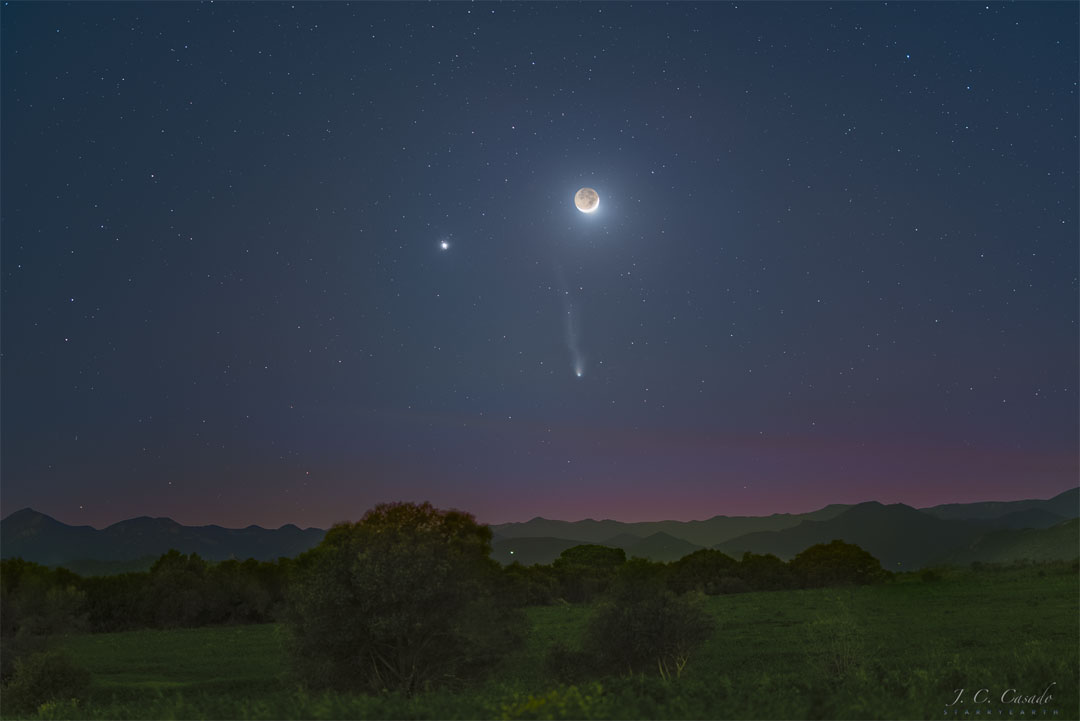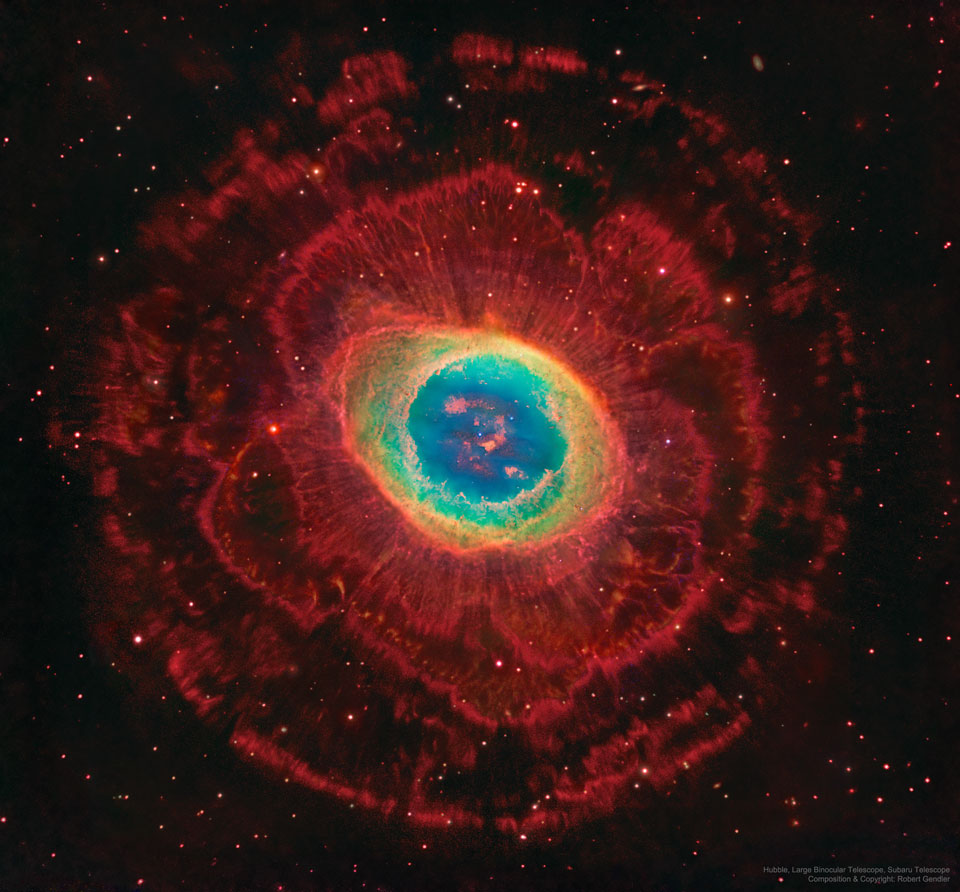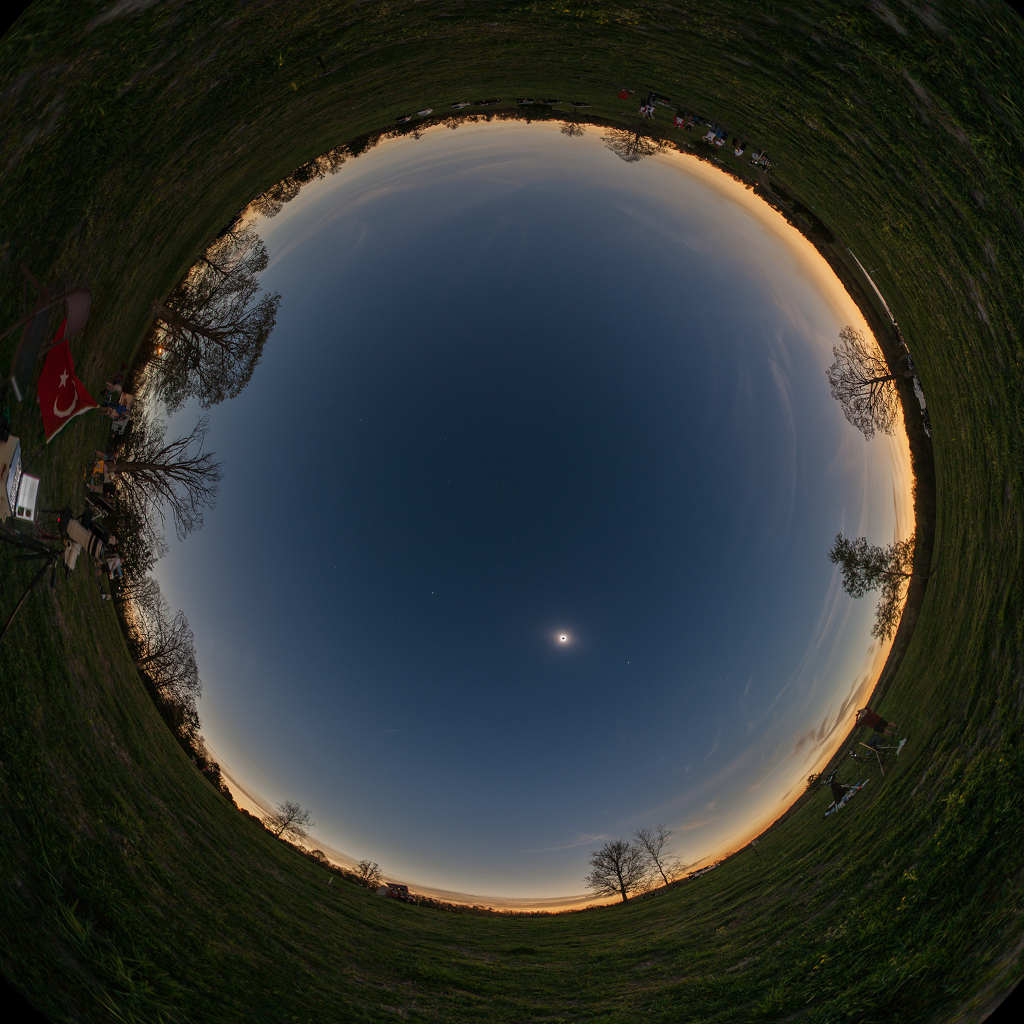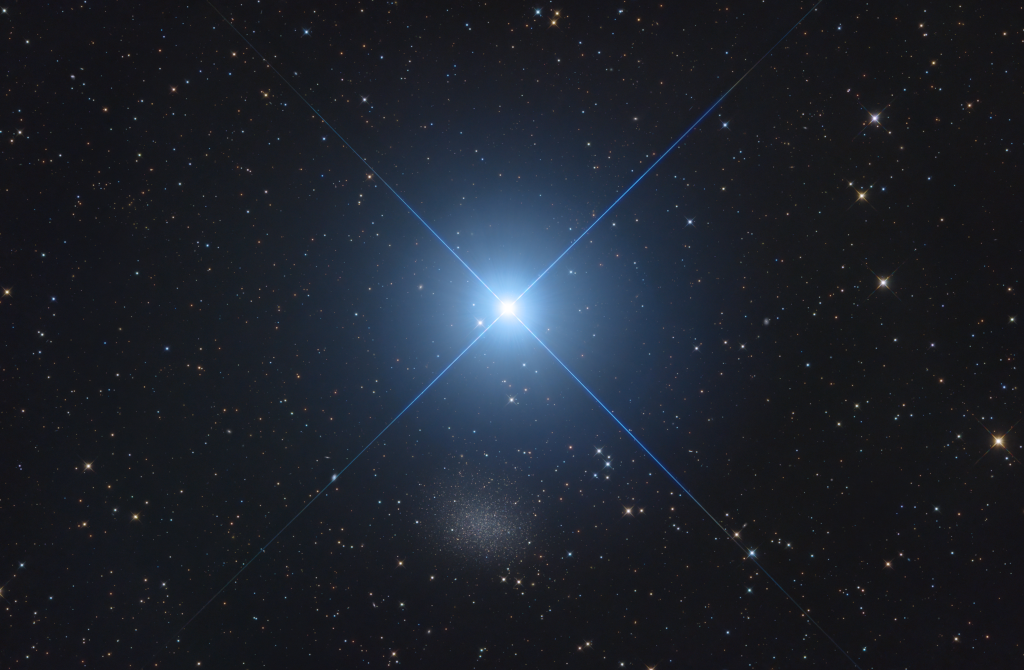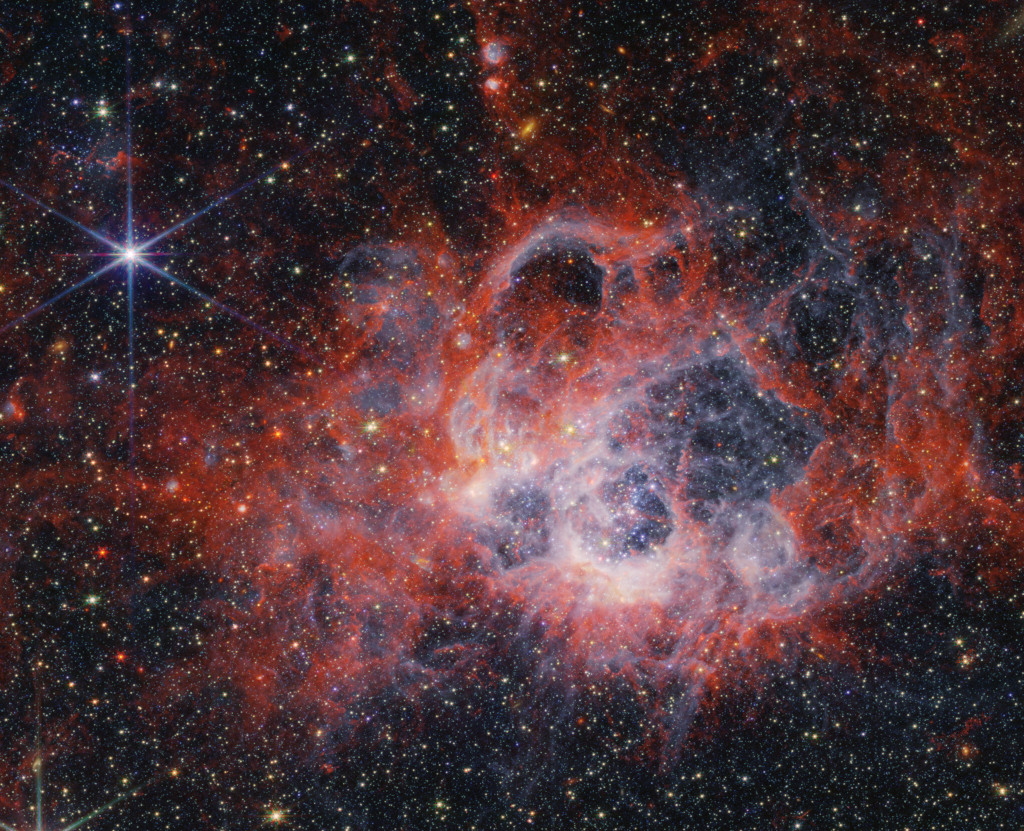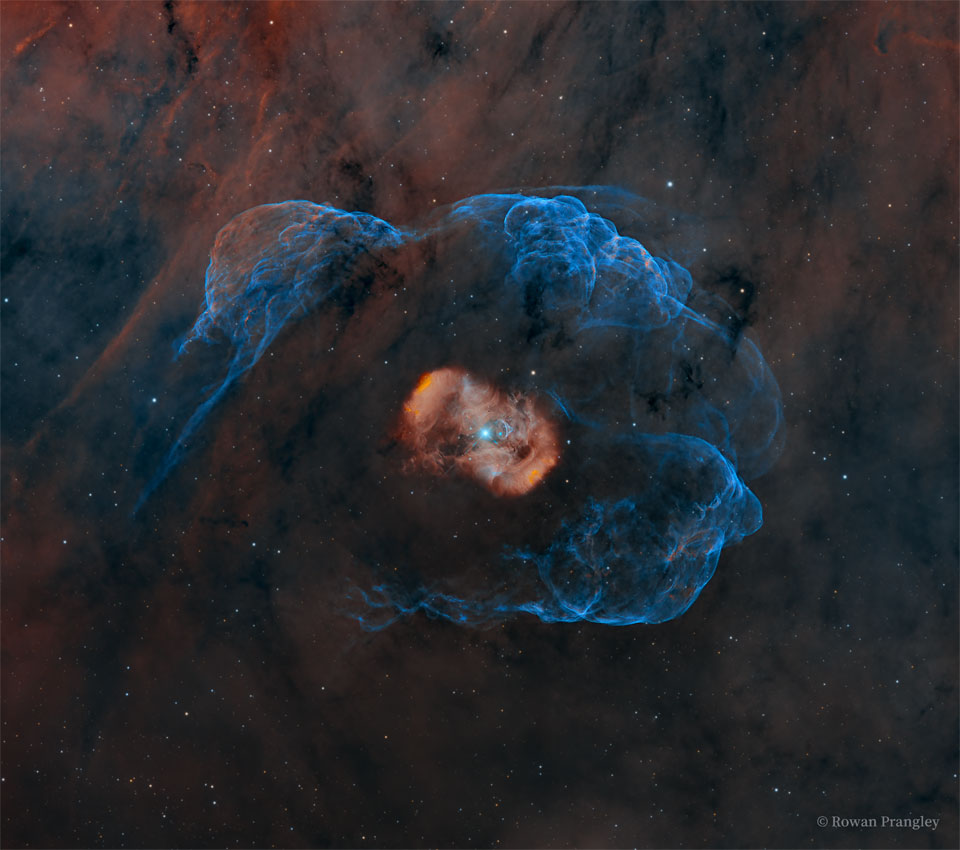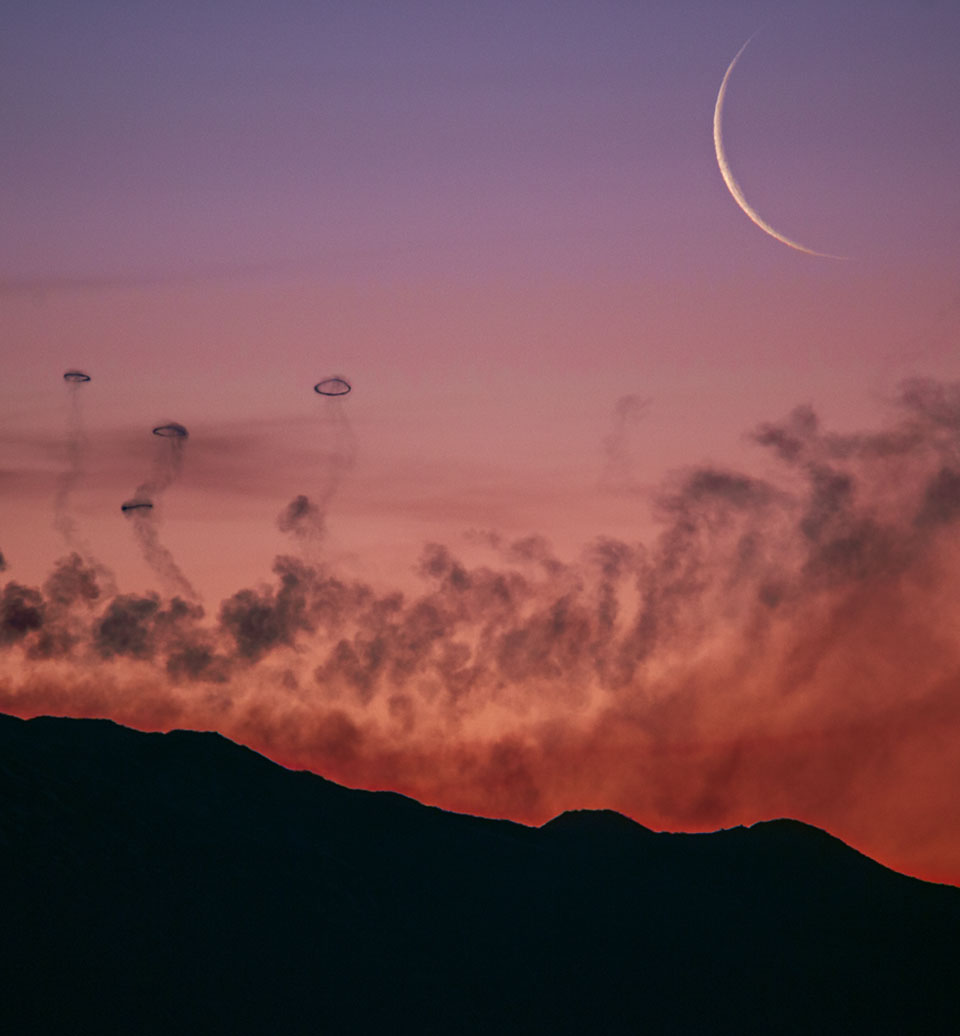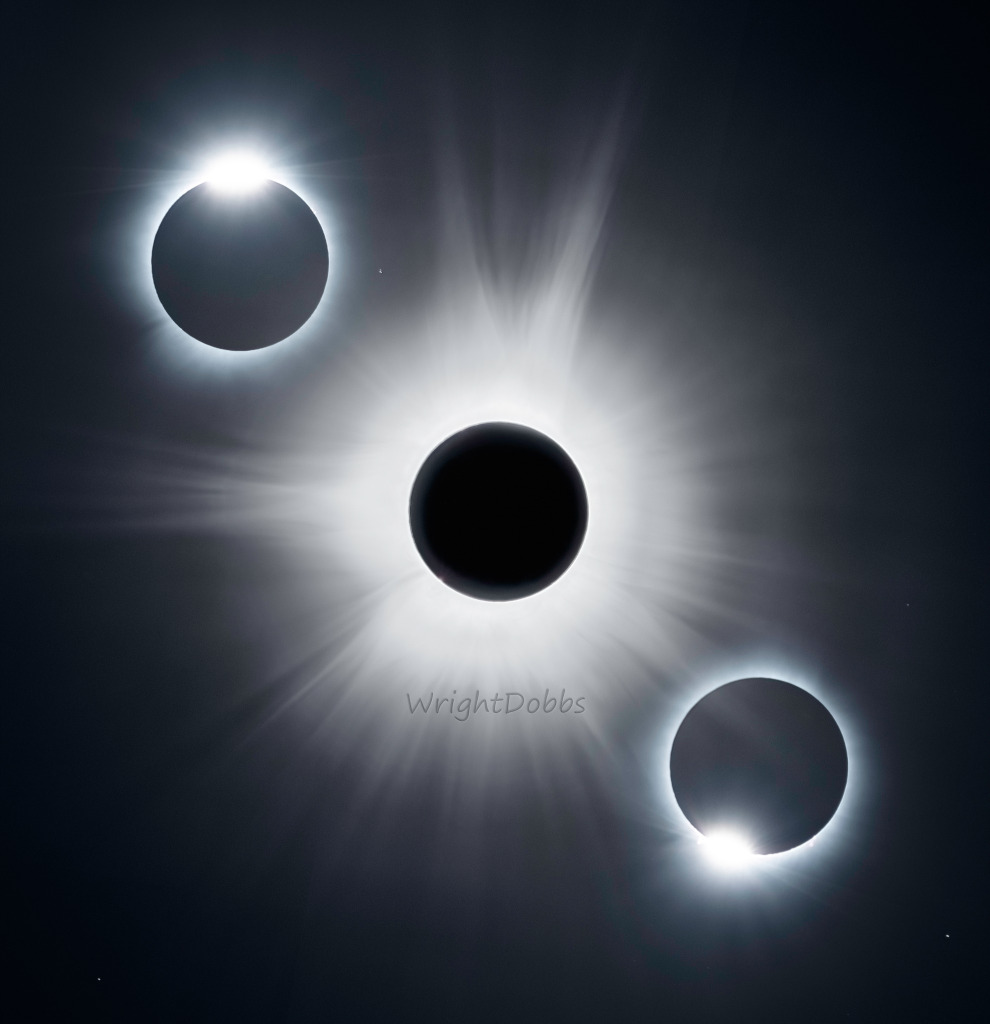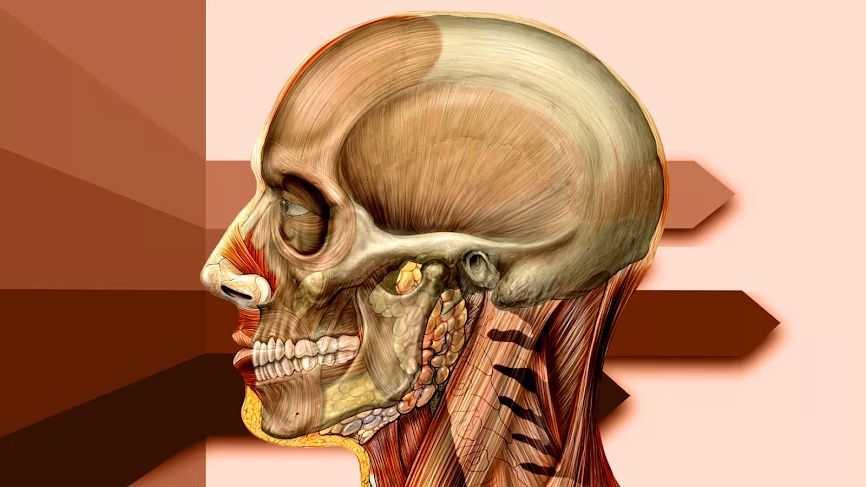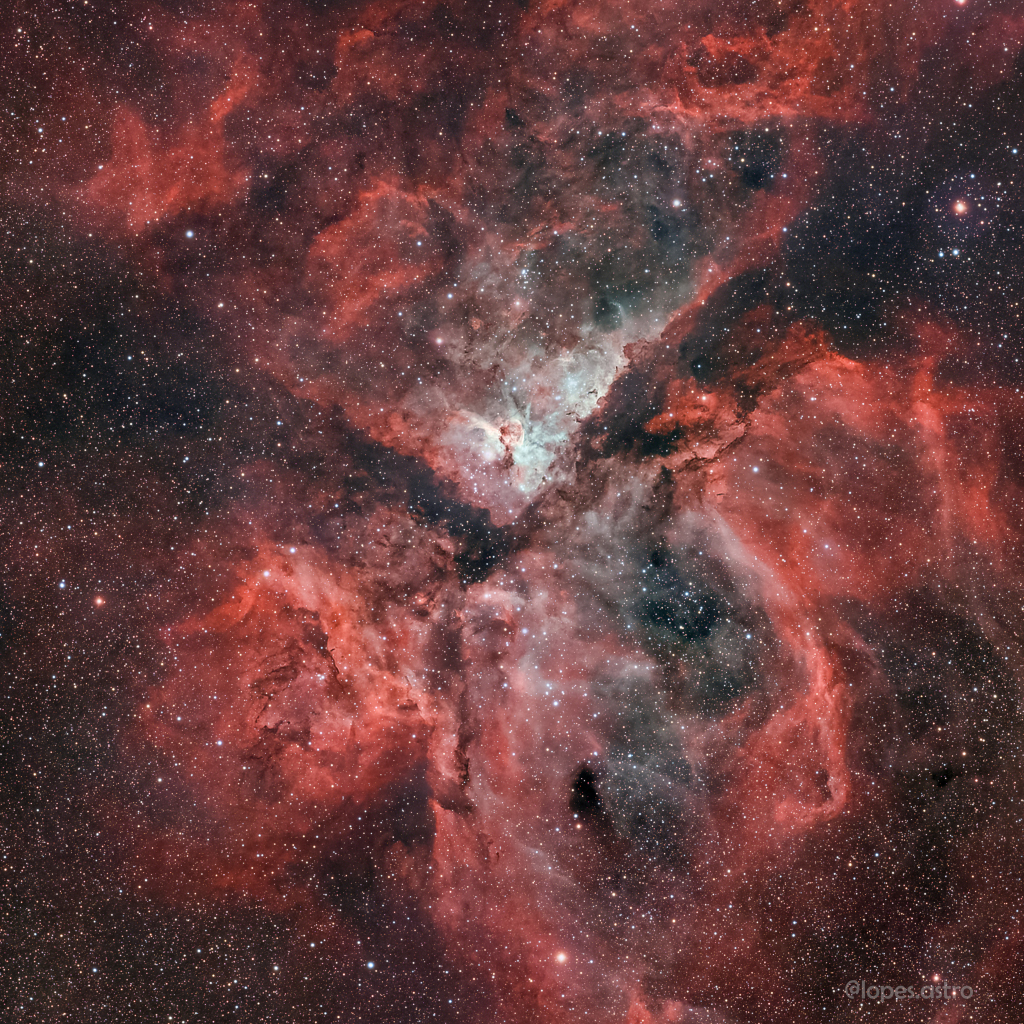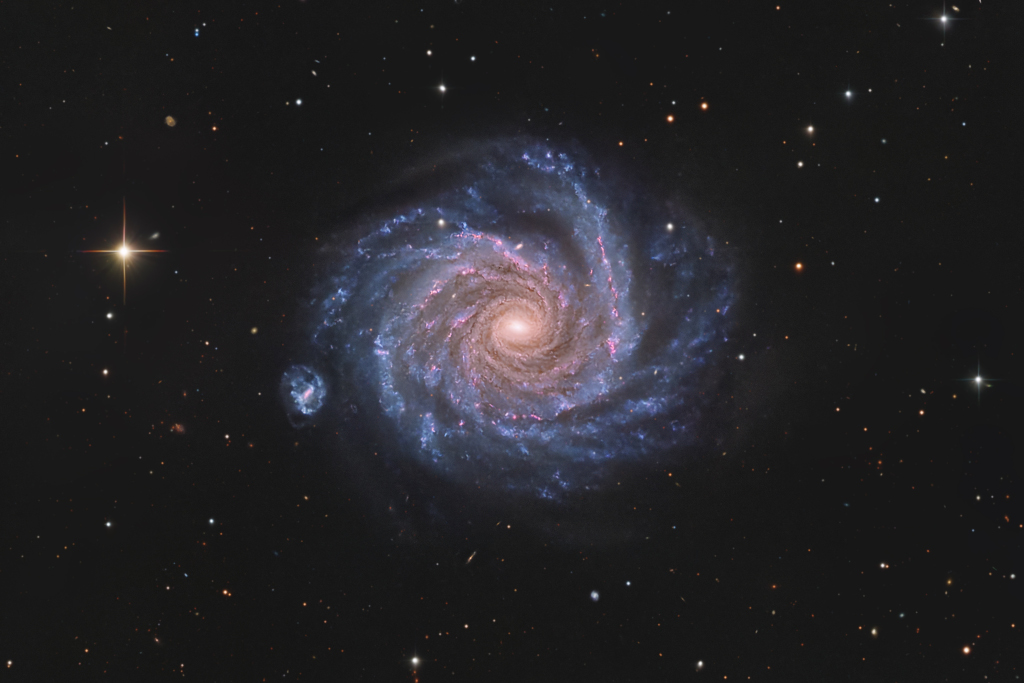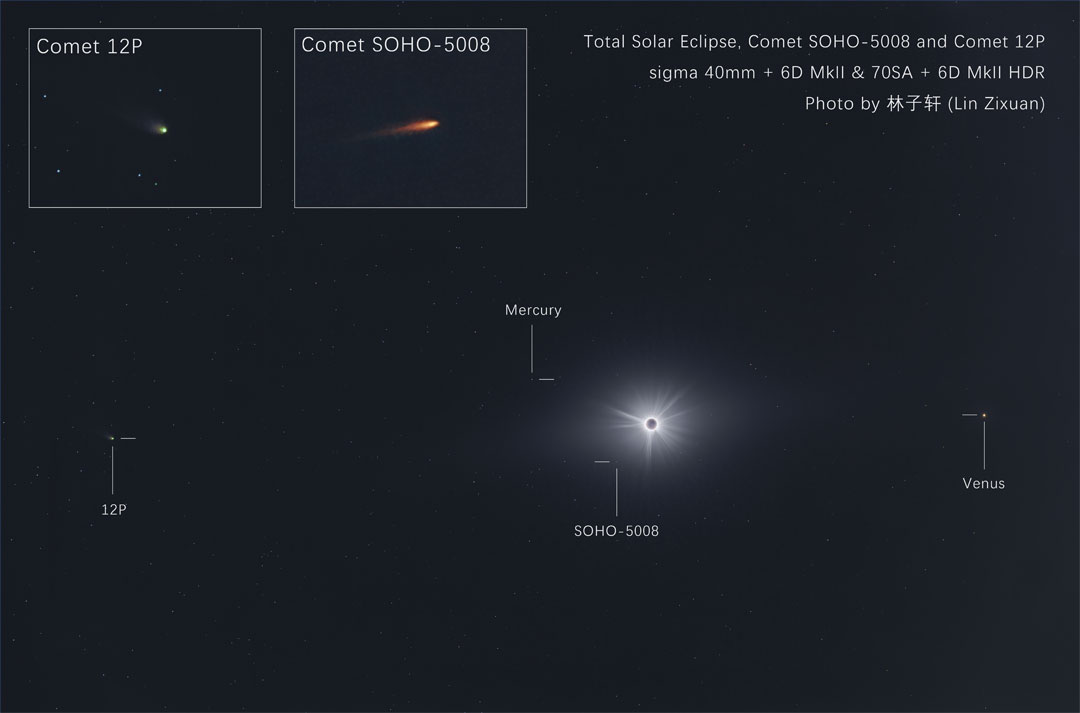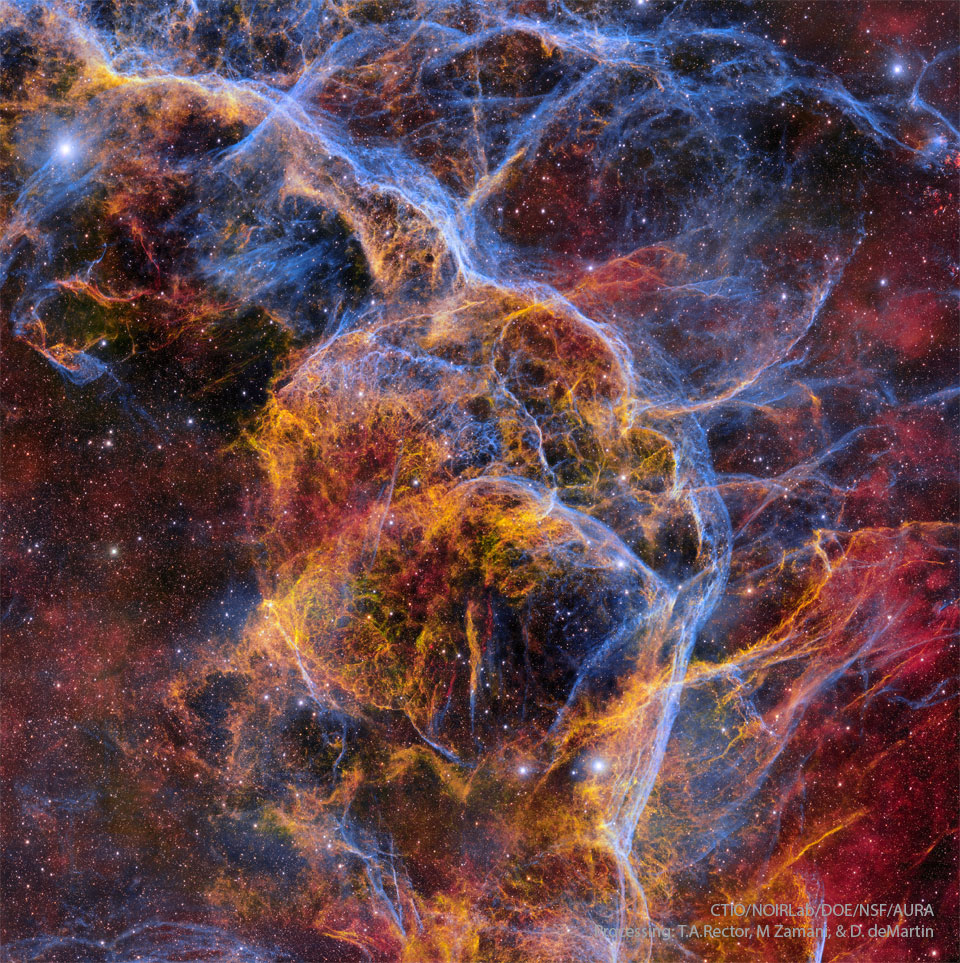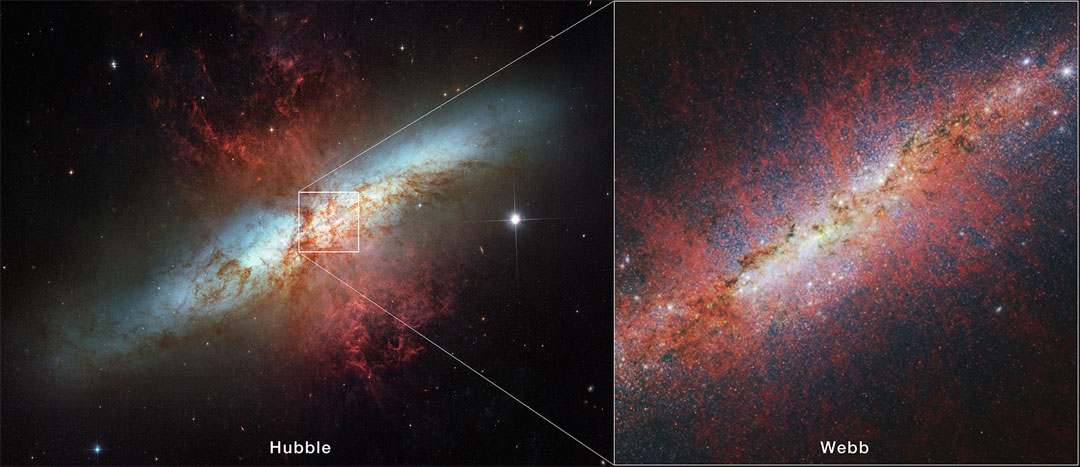Nombre total de pages vues
30/04/2024
SANTé/MEDECINE - Homme ou animal qui est le plus fort - Vision : les rapaces nous dépassent !
ASTRONOMY - GK Per: Nova and Planetary Nebula
2024 April 30
Image Credit & Copyright: Deep Sky Collective
Explanation: The star system GK Per is known to be associated with only two of the three nebulas pictured. At 1500 light years distant, Nova Persei 1901 (GK Persei) was the second closest nova yet recorded. At the very center is a white dwarf star, the surviving core of a former Sun-like star. It is surrounded by the circular Firework nebula, gas that was ejected by a thermonuclear explosion on the white dwarf's surface -- a nova -- as recorded in 1901. The red glowing gas surrounding the Firework nebula is the atmosphere that used to surround the central star. This gas was expelled before the nova and appears as a diffuse planetary nebula. The faint gray gas running across is interstellar cirrus that seems to be just passing through coincidently. In 1901, GK Per's nova became brighter than Betelgeuse. Similarly, star system T CrB is expected to erupt in a nova later this year, but we don't know exactly when nor how bright it will become.
29/04/2024
SANTé/MEDECINE - Homme ou animal qui est le plus fort ? - Taille du génome
ASTRONOMY - Comet, Planet, Moon
2024 April 29
Image Credit & Copyright: Juan Carlos Casado (Starry Earth, TWAN)
Explanation: Three bright objects satisfied seasoned stargazers of the western sky just after sunset earlier this month. The most familiar was the Moon, seen on the upper left in a crescent phase. The rest of the Moon was faintly visible by sunlight first reflected by the Earth. The bright planet Jupiter, the largest planet in the Solar System, is seen to the upper left. Most unusual was Comet 12P/Pons-Brooks, below the Moon and showing a stubby dust tail on the right but an impressive ion tail extending upwards. The featured image, a composite of several images taken consecutively at the same location and with the same camera, was taken near the village of Llers, in Spain's Girona province. Comet Pons-Brooks passed its closest to the Sun last week and is now dimming as it moves into southern skies and returns to the outer Solar System.
28/04/2024
NUCLEAIRE - Dangers de l'explosion
SANTé/MEDECINE - Homme ou animal : qui est le plus fort ? - Nombre de gènes
ASTRONOMY - Rings Around the Ring Nebula
2024 April 28
Image Credit: Hubble, Large Binocular Telescope, Subaru Telescope; Composition & Copyright: Robert Gendler
Explanation: The Ring Nebula (M57) is more complicated than it appears through a small telescope. The easily visible central ring is about one light-year across, but this remarkably deep exposure - a collaborative effort combining data from three different large telescopes - explores the looping filaments of glowing gas extending much farther from the nebula's central star. This composite image includes red light emitted by hydrogen as well as visible and infrared light. The Ring Nebula is an elongated planetary nebula, a type of nebula created when a Sun-like star evolves to throw off its outer atmosphere and become a white dwarf star. The Ring Nebula is about 2,500 light-years away toward the musical constellation Lyra.
27/04/2024
SANTé/MEDECINE - Homme ou animal : qui est le plus fort ? - Taille
ASTRONOMY - All Sky Moon Shadow
2024 April 27
Image Credit & Copyright: Tunc Tezel (TWAN)
Explanation: If the Sun is up but the sky is dark and the horizon is bright all around, you might be standing in the Moon's shadow during a total eclipse of the Sun. In fact, the all-sky Moon shadow shown in this composited panoramic view was captured from a farm near Shirley, Arkansas, planet Earth. The exposures were made under clear skies during the April 8 total solar eclipse. For that location near the center line of the Moon's shadow track, totality lasted over 4 minutes. Along with the solar corona surrounding the silhouette of the Moon planets and stars were visible during the total eclipse phase. Easiest to see here are bright planets Venus and Jupiter, to the lower right and upper left of the eclipsed Sun.
26/04/2024
SANTé/MEDECINE - Histoire - 2010 : un exosquelette pour faire remarcher les paraplégiques
ASTRONOMY - Regulus and the Dwarf Galaxy
2024 April 26
Image Credit & Copyright: Markus Horn
Explanation: In northern hemisphere spring, bright star Regulus is easy to spot above the eastern horizon. The alpha star of the constellation Leo, Regulus is the spiky star centered in this telescopic field of view. A mere 79 light-years distant, Regulus is a hot, rapidly spinning star that is known to be part of a multiple star system. Not quite lost in the glare, the fuzzy patch just below Regulus is diffuse starlight from small galaxy Leo I. Leo I is a dwarf spheroidal galaxy, a member of the Local Group of galaxies dominated by our Milky Way Galaxy and the Andromeda Galaxy (M31). About 800 thousand light-years away, Leo I is thought to be the most distant of the known small satellite galaxies orbiting the Milky Way. But dwarf galaxy Leo I has shown evidence of a supermassive black hole at its center, comparable in mass to the black hole at the center of the Milky Way.
25/04/2024
ASTRONOMY - NGC 604: Giant Stellar Nursery
2024 April 25
Image Credit: NASA, ESA, CSA, STScI
Explanation: Located some 3 million light-years away in the arms of nearby spiral galaxy M33, giant stellar nursery NGC 604 is about 1,300 light-years across. That's nearly 100 times the size of the Milky Way's Orion Nebula, the closest large star forming region to planet Earth. In fact, among the star forming regions within the Local Group of galaxies, NGC 604 is second in size only to 30 Doradus, also known as the Tarantula Nebula in the Large Magellanic Cloud. Cavernous bubbles and cavities in NGC 604 fill this stunning infrared image from the James Webb Space Telescope's NIRCam. They are carved out by energetic stellar winds from the region's more than 200 hot, massive, young stars, all still in early stages of their lives.
24/04/2024
ASTRONOMY - Dragon's Egg Bipolar Emission Nebula
2024 April 24
Image Credit & Copyright: Rowan Prangley
Explanation: How did a star form this beautiful nebula? In the middle of emission nebula NGC 6164 is an unusually massive star. The central star has been compared to an oyster's pearl and an egg protected by the mythical sky dragons of Ara. The star, visible in the center of the featured image and catalogued as HD 148937, is so hot that the ultraviolet light it emits heats up gas that surrounds it. That gas was likely thrown off from the star previously, possibly the result of a gravitational interaction with a looping stellar companion. Expelled material might have been channeled by the magnetic field of the massive star, in all creating the symmetric shape of the bipolar nebula. NGC 6164 spans about four light years and is located about 3,600 light years away toward the southern constellation Norma.
23/04/2024
ASTRONOMIE - Survolez un magnifique lac de lave de 200 km de diamètre sur la lune volcanique Io !
SANTé/MEDECINE - HISTOIRE - 1980 : invention de l'IRM
SANTé/MEDECINE - Les avancées contre le cancer
ASTRONOMY - Contrail Shadow X
2024 April 23
Image Credit & Copyright: Fatih Ekmen
Explanation: What created this giant X in the clouds? It was the shadow of contrails illuminated from below. When airplanes fly, humid engine exhaust may form water droplets that might freeze in Earth's cold upper atmosphere. These persistent streams of water and ice scatter light from the Sun above and so appear bright from below. On rare occasions, though, when the Sun is near the horizon, contrails can be lit from below. These contrails cast long shadows upwards, shadows that usually go unseen unless there is a high cloud deck. But that was just the case over Istanbul, Türkiye, earlier this month. Contrails occur all over planet Earth and, generally, warm the Earth when the trap infrared light but cool the Earth when they efficiently reflect sunlight. The image was taken by a surprised photographer in the morning on the way to work.
22/04/2024
SANTé/MEDECINE - Homme ou animal : qui est le plus fort ? - Vitesse
SANTé/MEDECINE - La compléxité de la tête humaine - Tête vue de côté avec les nerfs trijumeaux
ASTRONOMY - Moon and Smoke Rings from Mt. Etna
Image Credit & Copyright: Dario Giannobile
Explanation: Yes, but can your volcano do this? To the surprise of some, Mt. Etna emits, on occasion, smoke rings. Technically known as vortex rings, the walls of the volcano slightly slow the outside of emitted smoke puffs, causing the inside gas to move faster. A circle of low pressure develops so that the emitted puff of volcanic gas and ash loops around in a ring, a familiar geometric structure that can be surprisingly stable as it rises. Smoke rings are quite rare and need a coincidence of the right geometry of the vent, the right speed of ejected smoke, and the relative calmness of the outside atmosphere. In the featured image taken about two weeks ago from Gangi, Sicily, Italy, multiple volcanic smoke rings are visible. The scene is shaded by the red light of a dawn Sun, while a crescent Moon is visible in the background.
21/04/2024
SANTé/MEDECINE - La compléxité de la tête humaine - Angiographie de l’artère carotide
ASTRONOMY - Perijove 16: Passing Jupiter
2024 April 21
Video Credit & License: NASA, Juno, SwRI, MSSS, Gerald Eichstadt;
Music: The Planets, IV. Jupiter (Gustav Holst); USAF Heritage of America Band (via Wikipedia)
Explanation: Watch Juno zoom past Jupiter. NASA's robotic spacecraft Juno is continuing on its now month-long, highly-elongated orbits around our Solar System's largest planet. The featured video is from perijove 16, the sixteenth time that Juno passed near Jupiter since it arrived in mid-2016. Each perijove passes near a slightly different part of Jupiter's cloud tops. This color-enhanced video has been digitally composed from 21 JunoCam still images, resulting in a 125-fold time-lapse. The video begins with Jupiter rising as Juno approaches from the north. As Juno reaches its closest view -- from about 3,500 kilometers over Jupiter's cloud tops -- the spacecraft captures the great planet in tremendous detail. Juno passes light zones and dark belts of clouds that circle the planet, as well as numerous swirling circular storms, many of which are larger than hurricanes on Earth. As Juno moves away, the remarkable dolphin-shaped cloud is visible. After the perijove, Jupiter recedes into the distance, now displaying the unusual clouds that appear over Jupiter's south. To get desired science data, Juno swoops so close to Jupiter that its instruments are exposed to very high levels of radiation.
20/04/2024
SANTé/MEDECINE - Homme ou animal : qui est le plus fort ? - Le cerveau
SANTé/MEDECINE - Signes d’une consommation excessive de sucre
ASTRONOMY - Diamonds in the Sky
2024 April 20
Image Credit & Copyright: Wright Dobbs
Explanation: When the dark shadow of the Moon raced across North America on April 8, sky watchers along the shadow's narrow central path were treated to a total solar eclipse. During the New Moon's shadow play diamonds glistened twice in the eclipse-darkened skies. The transient celestial jewels appeared immediately before and after the total eclipse phase. That's when the rays of a vanishing and then emerging sliver of solar disk are just visible behind the silhouetted Moon's edge, creating the appearance of a shiny diamond set in a dark ring. This dramatic timelapse composite from north-central Arkansas captures both diamond ring moments of this total solar eclipse. The diamond rings are separated by the ethereal beauty of the solar corona visible during totality.
19/04/2024
SANTé/MEDECINE - La compléxité de la tête humaine - Anatomie de la tête de côté avec le crâne
ASTRONOMY - The Great Carina Nebula
2024 April 19
Image Credit & Copyright: Demison Lopes
Explanation: A jewel of the southern sky, the Great Carina Nebula is more modestly known as NGC 3372. One of our Galaxy's largest star forming regions, it spans over 300 light-years. Like the smaller, more northerly Great Orion Nebula, the Carina Nebula is easily visible to the unaided eye. But at a distance of 7,500 light-years it lies some 5 times farther away. This stunning telescopic view reveals remarkable details of the region's glowing filaments of interstellar gas and obscuring cosmic dust clouds. The Carina Nebula is home to young, extremely massive stars, including the still enigmatic variable Eta Carinae, a star with well over 100 times the mass of the Sun. Eta Carinae is the bright star above the central dark notch in this field and left of the dusty Keyhole Nebula (NGC 3324).
18/04/2024
SANTé/MEDECINE - HISTOIRE - 1981 : découverte du Sida
ASTRONOMY - Facing NGC 1232
2024 April 18
Image Credit & Copyright: Neil Corke
Explanation: From our vantage point in the Milky Way Galaxy, we see NGC 1232 face-on. Nearly 200,000 light-years across, the big, beautiful spiral galaxy is located some 47 million light-years away in the flowing southern constellation of Eridanus. This sharp, multi-color, telescopic image of NGC 1232 includes remarkable details of the distant island universe. From the core outward, the galaxy's colors change from the yellowish light of old stars in the center to young blue star clusters and reddish star forming regions along the grand, sweeping spiral arms. NGC 1232's apparent, small, barred-spiral companion galaxy is cataloged as NGC 1232A. Distance estimates place it much farther though, around 300 million light-years away, and unlikely to be interacting with NGC 1232. Of course, the prominent bright star with the spiky appearance is much closer than NGC 1232 and lies well within our own Milky Way.
17/04/2024
SANTé/MEDECINE - Le corps humain vu de l'intérieur - Les rayons X, des pionniers qui ont bien évolué
SANTé/MEDECINE - HISTOIRE - 1967 : première transplantation cardiaque par Barnard
ASTRONOMY - Total Eclipse and Comets
2024 April 17
Image Credit & Copyright: Lin Zixuan (Tsinghua U.)
Explanation: Not one, but two comets appeared near the Sun during last week's total solar eclipse. The expected comet was Comet 12P/Pons-Brooks, but it was disappointingly dimmer than many had hoped. However, relatively unknown Comet SOHO-5008 also appeared in long duration camera exposures. This comet was the 5008th comet identified on images taken by ESA & NASA's Sun-orbiting SOHO spacecraft. Likely much smaller, Comet SOHO-5008 was a sungrazer which disintegrated within hours as it passed too near the Sun. The featured image is not only unusual for capturing two comets during an eclipse, but one of the rare times that a sungrazing comet has been photographed from the Earth's surface. Also visible in the image is the sprawling corona of our Sun and the planets Mercury (left) and Venus (right). Of these planets and comets, only Venus was easily visible to millions of people in the dark shadow of the Moon that crossed North America on April 8.
16/04/2024
INVENTEURS TUéS PAR LEURS CREATIONS - Donald Campbell
SANTé/MEDECINE - La complexité de la tête humaine - Anatomie de la face vue du côté
SANTé/MEDECINE - HISTOIRE - La lobotomie pratiquée jusque dans les années 1960
ASTRONOMY - Filaments of the Vela Supernova Remnant
2024 April 16
Image Credit: CTIO, NOIRLab, DOE, NSF, AURA; Processing: T. A. Rector (U. Alaska Anchorage), M. Zamani & D. de Martin (’s NOIRLab)
Explanation: The explosion is over, but the consequences continue. About eleven thousand years ago, a star in the constellation of Vela could be seen to explode, creating a strange point of light briefly visible to humans living near the beginning of recorded history. The outer layers of the star crashed into the interstellar medium, driving a shock wave that is still visible today. The featured image captures some of that filamentary and gigantic shock in visible light. As gas flies away from the detonated star, it decays and reacts with the interstellar medium, producing light in many different colors and energy bands. Remaining at the center of the Vela Supernova Remnant is a pulsar, a star as dense as nuclear matter that spins around more than ten times in a single second.
15/04/2024
SANTé/MEDECINE - La compléxité de la tête humaine - Anatomie de la tête et radiographie
SANTé/MEDECINE - Le corps humain vu de l'intérieur - L'échographie, une aide au diagnostic
SANTé/MEDECINE - 1953 : découverte de la structure de l'ADN en double hélice
ASTRONOMY -The Cigar Galaxy from Hubble and Webb
2024 April 15
Image Credit: NASA, ESA, CSA, STScI, Alberto Bolatto (UMD)
Explanation: Something strange happened to this galaxy, but what? Known as the Cigar Galaxy and cataloged as M82, red glowing gas and dust are being cast out from the center. Although this starburst galaxy was surely stirred up by a recent pass near its neighbor, large spiral galaxy M81, this doesn't fully explain the source of the red-glowing outwardly expanding gas and dust. Evidence indicates that this material is being driven out by the combined emerging particle winds of many stars, together creating a galactic superwind. In the featured images, a Hubble Space Telescope image in visible light is shown on the left, while a James Webb Space Telescope image of the central region in infrared light is shown on the right. Detailed inspection of the new Webb image shows, unexpectedly, that this red-glowing dust is associated with hot plasma. Research into the nature of this strange nearby galaxy will surely continue.
14/04/2024
SANTé/MEDECINE - La compléxité de la tête humaine - Anatomie de la tête : nerfs de la face
ASTRONOMY - How a Total Solar Eclipse Ended
024 April 14
Video Credit & Copyright: David Duarte
Explanation: How does a total solar eclipse end? Yes, the Moon moves out from fully blocking the Sun, but in the first few seconds of transition, interesting things appear. The first is called a diamond ring. Light might stream between mountains or through relative lowlands around the Moon's edge, as seen from your location, making this sudden first light, when combined with the corona that surrounds the Moon, look like a diamond ring. Within seconds other light streams appear that are called, collectively, Bailey's beads. In the featured video, it may seem that the pink triangular prominence on the Sun is somehow related to where the Sun begins to reappear, but it is not. Observers from other locations saw Bailey's beads emerge from different places around the Moon, away from the iconic triangular solar prominence visible to all. The video was captured with specialized equipment from New Boston, Texas, USA on April 8, 2024.
13/04/2024
SANTé/MEDECINE - Le corps humain vu de l'intérieur - Coeur - cerveau et...tumeurs
SANTé/MEDECINE - La compléxité de la tête humaine - Anatomie de la tête vue de face
ASTRONOMY - Orion and the Ocean of Storms
2025 December 13 Orion and the Ocean of Storms Image Credit: NASA , Artemis 1 Explanation: On December 5, 2022, a camera on board the u...

-
2022 September 26 All the Water on Planet Earth Illustration Credit: Jack Cook, Adam Nieman, Woods Hole Oceanographic Institution ; Data ...
-
2025 May 11 The Surface of Venus from Venera 14 Image Credit: Soviet Planetary Exploration Program , Venera 14 ; Processing & Copyri...

